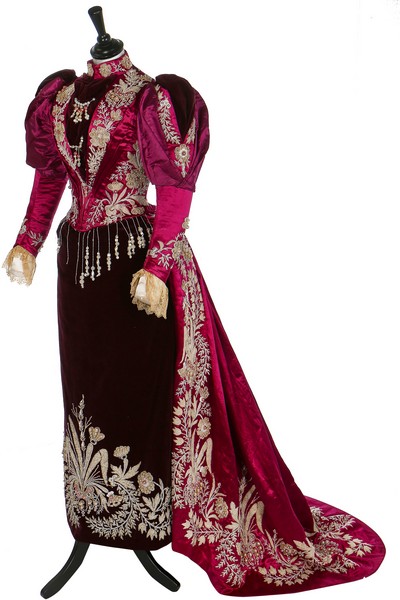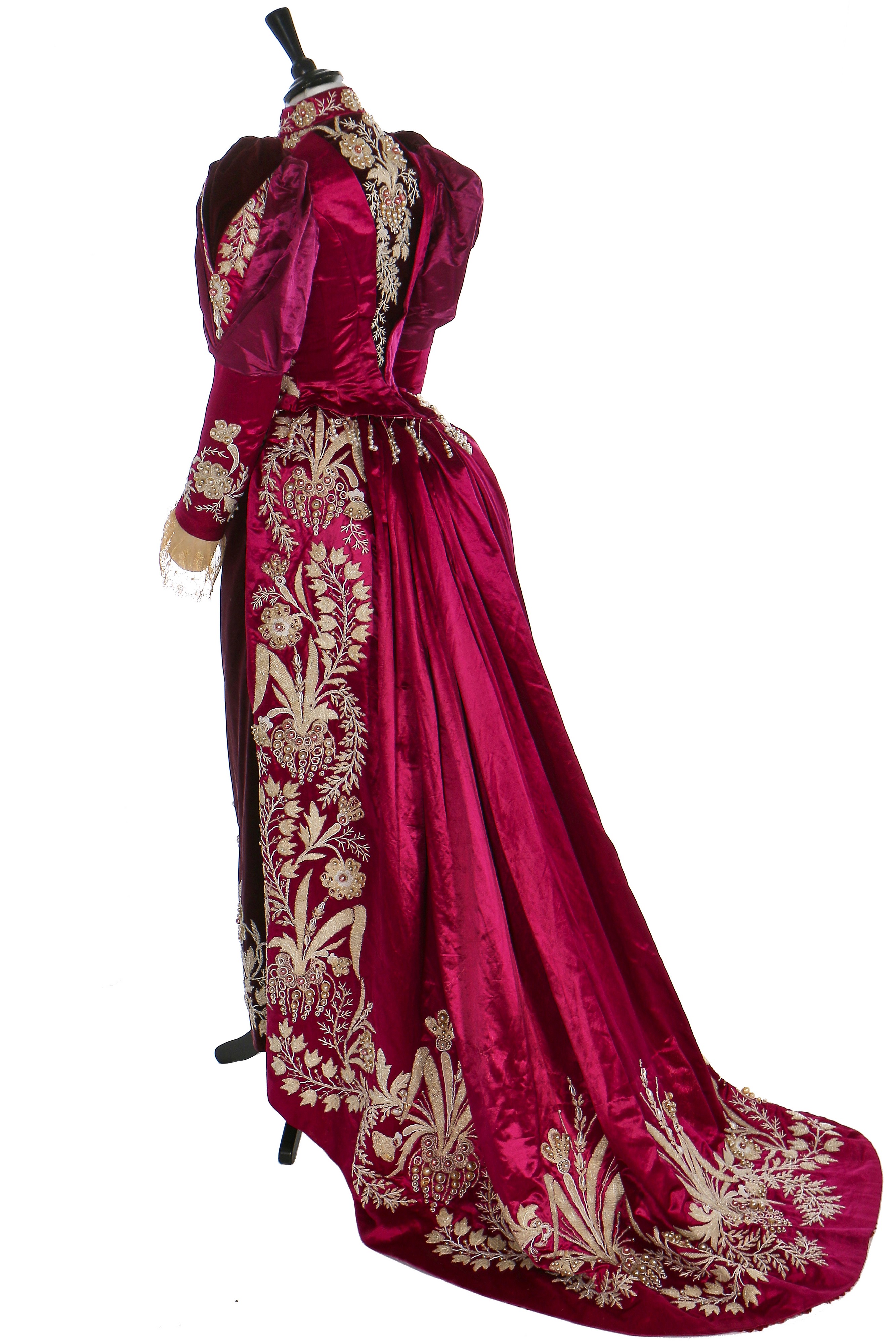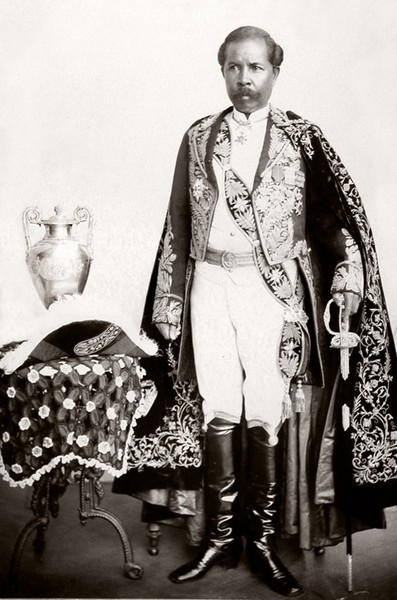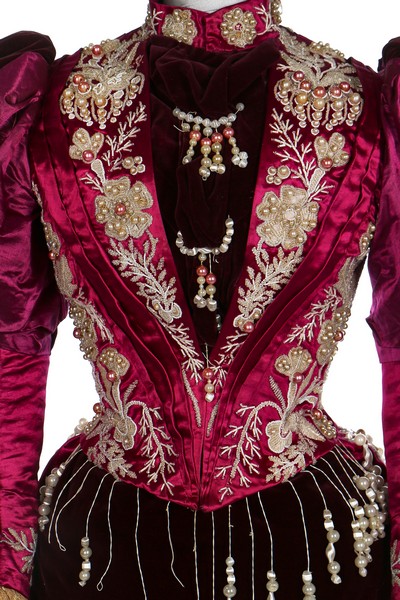

Read the incredible story behind lot 51 in our Passion for Fashion sale on 8th December...
16/11/2020
This fascinating horde of fashion, photographs and ephemera relating to Queen Ranavalona III was recently discovered during a house move by a descendant of Miss Clara Herbert (1855- c.1930), the daughter of a shoe maker, and local preacher, and whose brother became Sir Jesse Herbert, a senior member of the Liberal Party of the day. The family’s ancestral home had been Muckross House county Kerry, but they were almost bankrupted by a royal visit by Queen Victoria in the 1860s, sold up and moved to Reading. A lady of genteel upbringing, but little money and a talented linguist, she sought employment as a paid companion. Clara was fluent in French, Malagasy and seven Chinese dialects. According to her family she worked for the Madagascan Royal family from the late 1890s until the early 1920s, accompanying them through their trials, tribulations and adventures.
.jpg)
.jpg)
Left: the Royal family with companions, one of them possibly Miss Herbert; right: Images of Queen Ranavalona III
The archive so carefully compiled and preserved by Miss Herbert gives a glimpse into the lives of the Queen and the women who surrounded her and includes poignant images of Ranavalona, seated regally on her throne in Madagascar during the last days of her reign. Her crown and dias which were seized by the French have just recently been returned to Madagascar. The 19th century was very much the age of empire with France and Britain being foremost among the nations eager to acquire other countries. The French turned their attention to Madagascar during the 1880s and regularly made attacks, culminating in 1895 with the landing of tens of thousands of troops (many of them died of malaria). The island was officially annexed in 1895; in 1896 the monarchy was abolished and in 1897 Queen Ranavalona, accompanied by close family and a handful of servants, was sent into exile to the island of Réunion. To be fair, the French did abolish slavery on the island as a matter of urgency!
.jpg)
.jpg)
The family in exile on Réunion
Photographed in Réunion in the early days of her captivity, she looks thin, downcast and stands outside a palatial wooden villa with her older sister Princess Rasendranoro (on the right) and influential aunt – Princess Ramasindrazana (on the left) and nephew (in the bowler hat), Prince Rakotomena. Princess Rasendranoro's daughter Princess Razafinandriamanitra, pictured below centre, also acompanied them. The fourteen-year-old princess was nine months pregnant with the illegitimate child of a French soldier.
.jpg)
.jpg)

Queen Ranavalona III on exile in Réunion Princess Razafinandriamanitra Prince Rakotomena
Two days after arriving at Réunion, Razafinandriamanitra gave birth to a daughter, but the labour and journey had been too much for her and she died. The infant Marie-Louise was duly adopted by Queen Ranavalona and was made her heir as she had no children of her own.
.jpg)
.jpg)
Left: The family, including Ranavalona and her great-niece as a toddler. The French officer is probably her god father – French officer Alfred Durand
Right: Queen Ranavalona III circa 1900 in Algeria wearing European high fashion and exotic headdress, the dress bearing Madagascar flowers
The Queen was supported as always by her influential Aunt - Ramasindrazana, who had acted as her political advisor during her reign and had been something of a thorn in the side of the French authorities. She was blamed for helping to incite rebellions against the French colonialists, and although many of her male conspirators and relations were executed, they balked at killing a woman, so she was packed off to Réunion with the Queen instead.



Part of 51, estimate £1,000-1,500: Princess Ramasindrazana's dress
Ranavalona’s husband (and old enough to be her father) was Prime Minister Rainilaiarivony. He had been sent into exile a year earlier to Algiers but died within a few months there, leaving Ranavalona even more defenceless. It had been the tradition that the Queen married the Prime Minister. Indeed, he had been married to the two previous Queens and it was rumoured that he had poisoned Ranavalona's first husband (making her a widow at just 22), when it seemed likely she would accede to the throne after the death of her aunt Queen Ranavalona II. However, this group of strong women managed perfectly well without him!

.jpg)
Prime Minister Rainilaiarivony Queen Ranavalona III, circa 1892
The French authorities, nervous of new uprisings in Madagascar, decided to put more distance between the Queen and her people. So, in 1899, the Queen and her entourage were peremptorily ordered to board a ship bound for France. Ranavalona was initially pleased, as she hoped to be exiled in Paris (she liked to order clothes from French couture houses), but upon docking in Marseilles she learned that their final destination was to be Algeria. She burst into tears and declared, 'Who is certain of tomorrow? Only yesterday I was a queen; today I am simply an unhappy, broken-hearted woman.'
.jpg)
.jpg)
Queen Ranavalona was featured in song (left) and even on biscuit wrappers (right)
However, Algeria wasn't too bad - it had a sophisticated and thriving social life and the Queen soon became something of a cause célèbre. The archive includes musical programmes dedicated to her.

Queen Ranavalona III on holiday in France, c.1903
The Queen and her entourage were eventually allowed to visit France for the first time in 1901 for holidays and shopping trips where they were followed and photographed by the press. She became hugely popular with the general public who complained of France’s harsh treatment of the Queen and campaigned to increase her relatively meagre living allowance. Her picture even appeared on biscuit wrappers! Photographs of Ranavalona and Ramasindrazana around 1905 show them dressed in French finery, looking relaxed and happy and almost unrecognizable from the photographs taken in Réunion some years earlier.
.jpg)
Queen Ranavalona III and Princess Ramasindrazana, circa 1905
Her older sister died in Algiers in 1901, as did the Queen herself of an embolism in 1917 and the archive includes invitations to her funeral as well as the exhumation certificates for Princess Rasendranoro in 1907. Queen Ranavalona was also later exhumed and re-interred in the tomb of Queen Rasoherina at the Rova of Antananarivo in Madagascar. Although she was never permitted to re-visit her country during her lifetime it was ultimately her final resting place.
.jpg)
Left: the family, c.1912 Right: Princess Ramasindrazana, c.1920
After Ranavalona’s death in 1917, Princess Ramasindrazana was finally given permission to leave Algiers and moved to the Alpes Maritimes, France, where she was accompanied by the loyal Miss Herbert.

After Princess Ramasindrazana's illness and death in 1924, Miss Herbert briefly sought work in Nice working for a wealthy Italian lady (her work contract is included) before returning to Reading and then travelling to China to work as a Methodist missionary. Her time spent with the Madagascan Royal family obviously meant a lot to her as she so carefully preserved the vibrant and ornate evening gown of Princess Ramasindrazana (so different to the sombre black clothes she herself wore), the personal letters, photographs, souvenirs and ephemera down to jottings of the smallest receipts, all meticulously boxed and put away and discovered after her death in the 1930s. Her time with the Madagascar Royal family must have been the adventure of her life!


Left: needlecase and Honiton stocking belonging to Queen Ranavalona III
Ranavalona’s heir apparent and pretender to the Madagascar throne – the illegitimate Princess Marie Louise was sent to France to study and married a French agricultural engineer in 1921. Although she continued to receive a small pension from the French government, she chose to pursue a career as a nurse and was awarded the Légion d’Honneur for her service during WWII. She got divorced and enjoyed her new-found freedom to the full, becoming a flamboyant and vivacious socialite. She was buried in Montreuil, France in 1948, without any descendants, finally ending the line of the Queens of Madagascar.
It is incredibly rare to find high fashion of the late 19th century worn by black women, and even more rare to find such a wealth of documents, photographs and ephemera to augment our understanding of them.